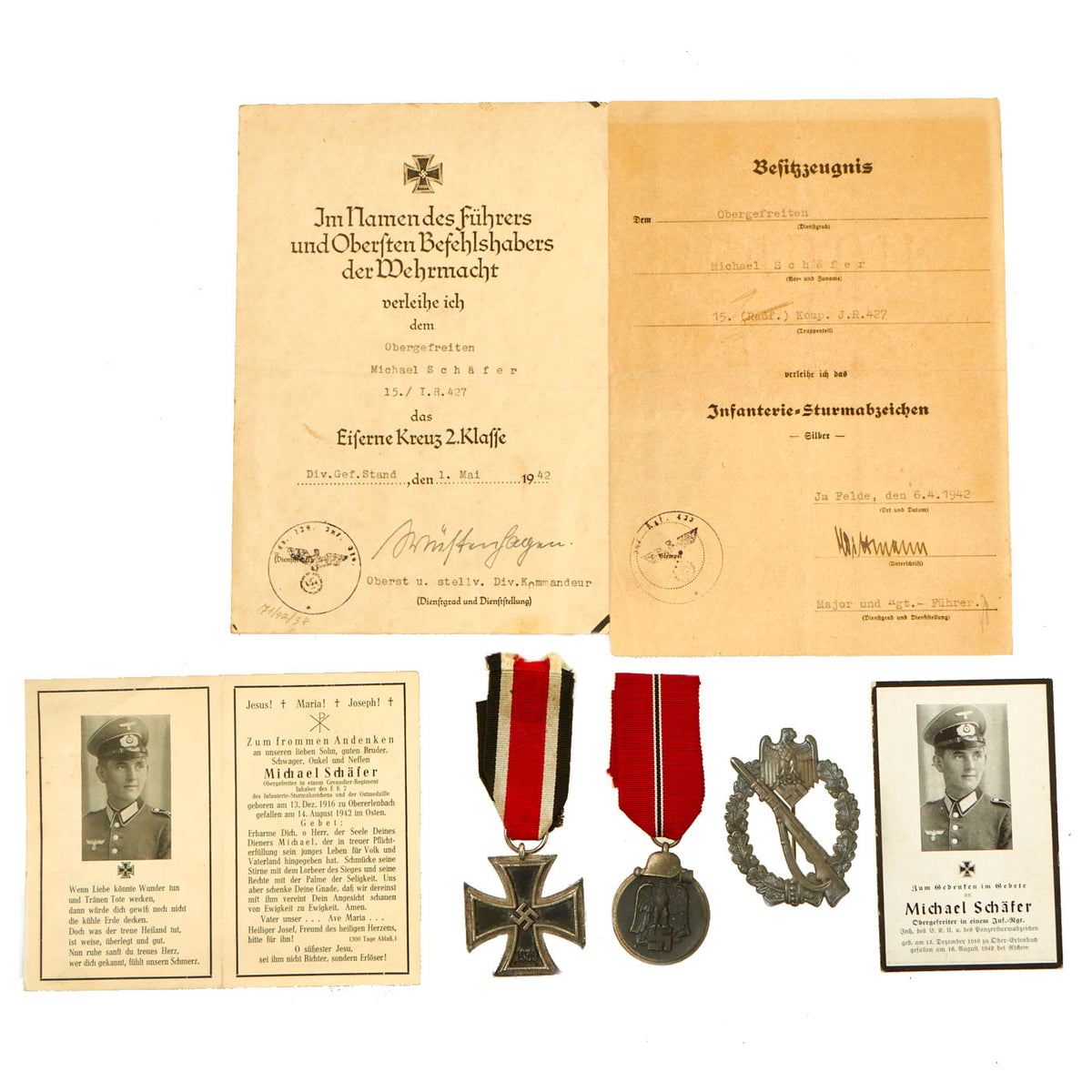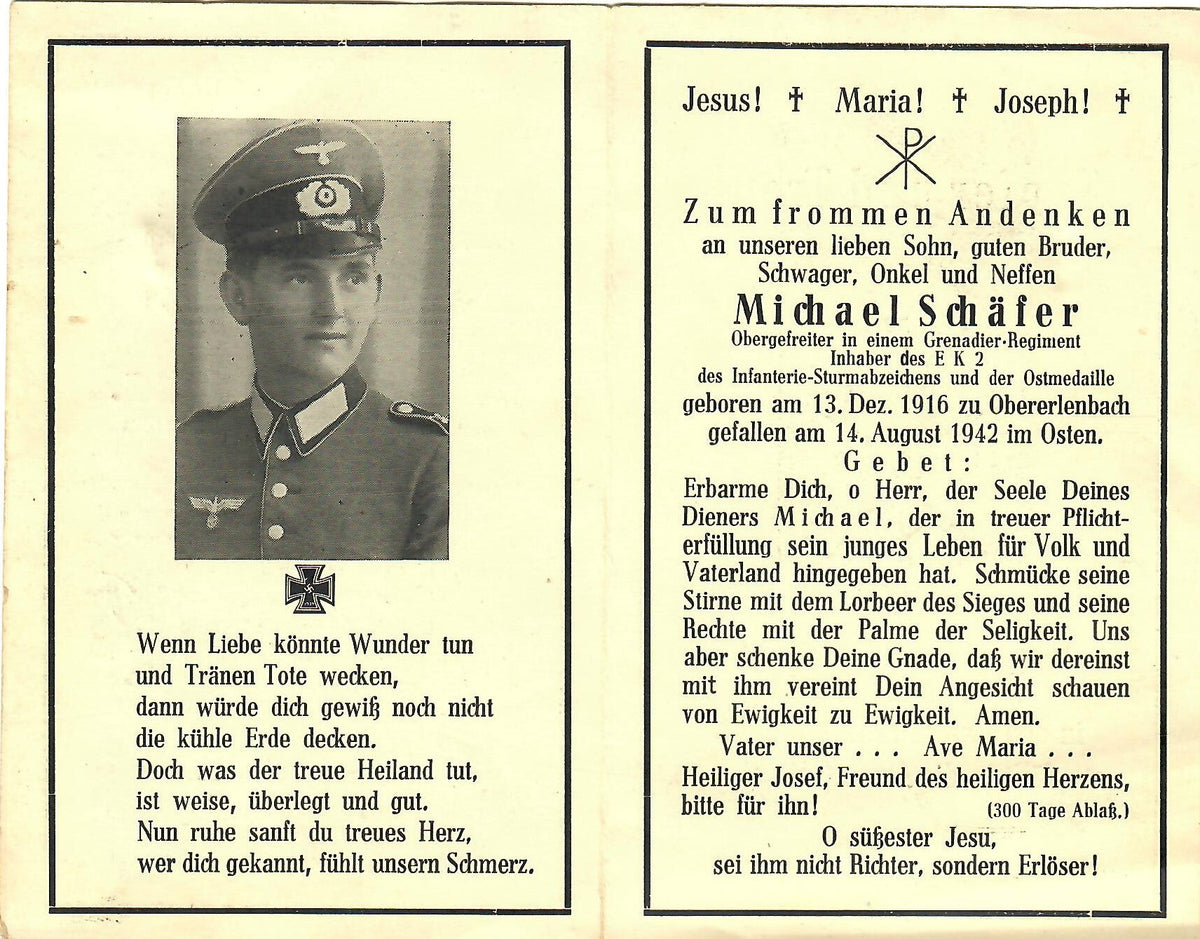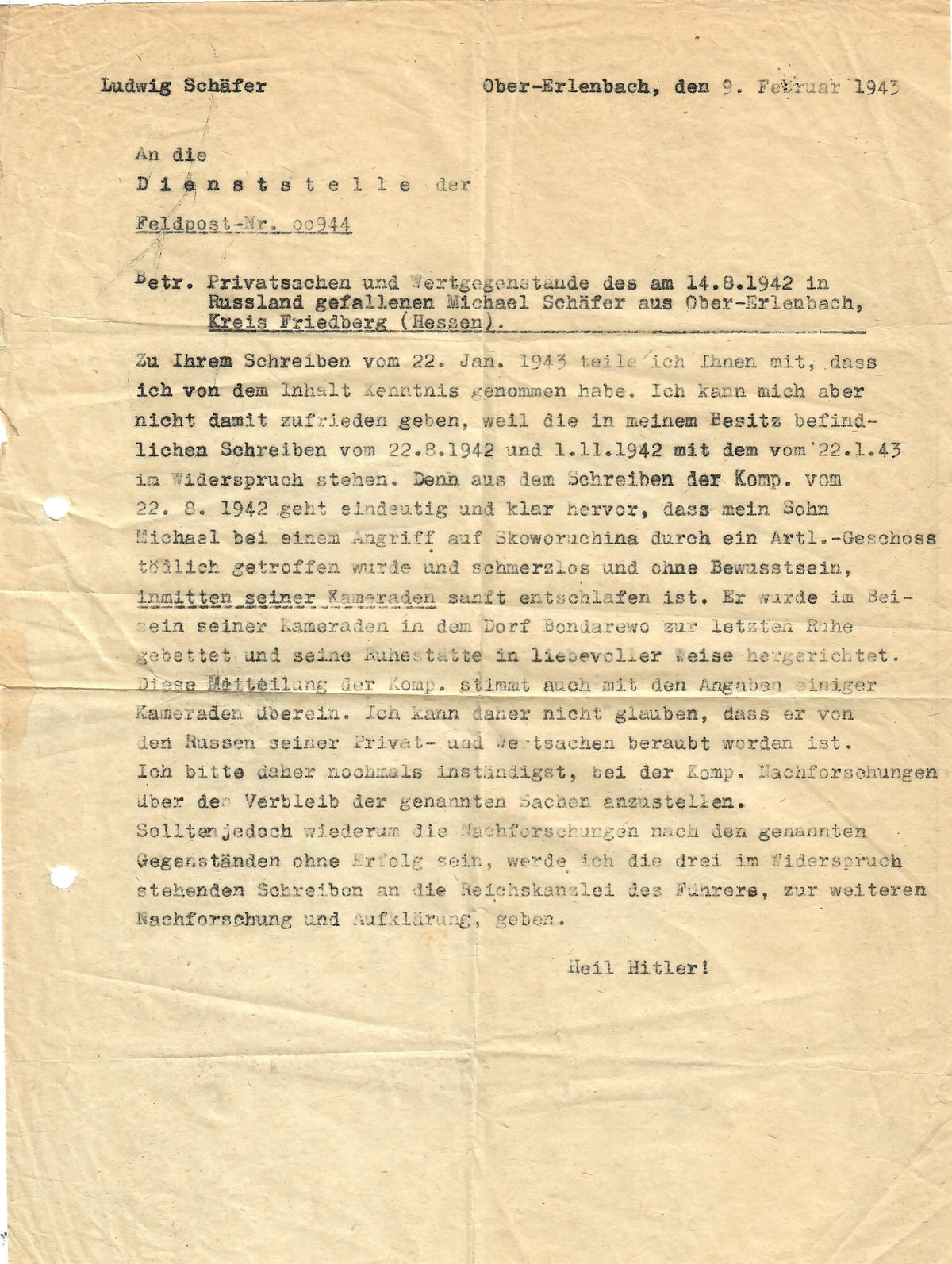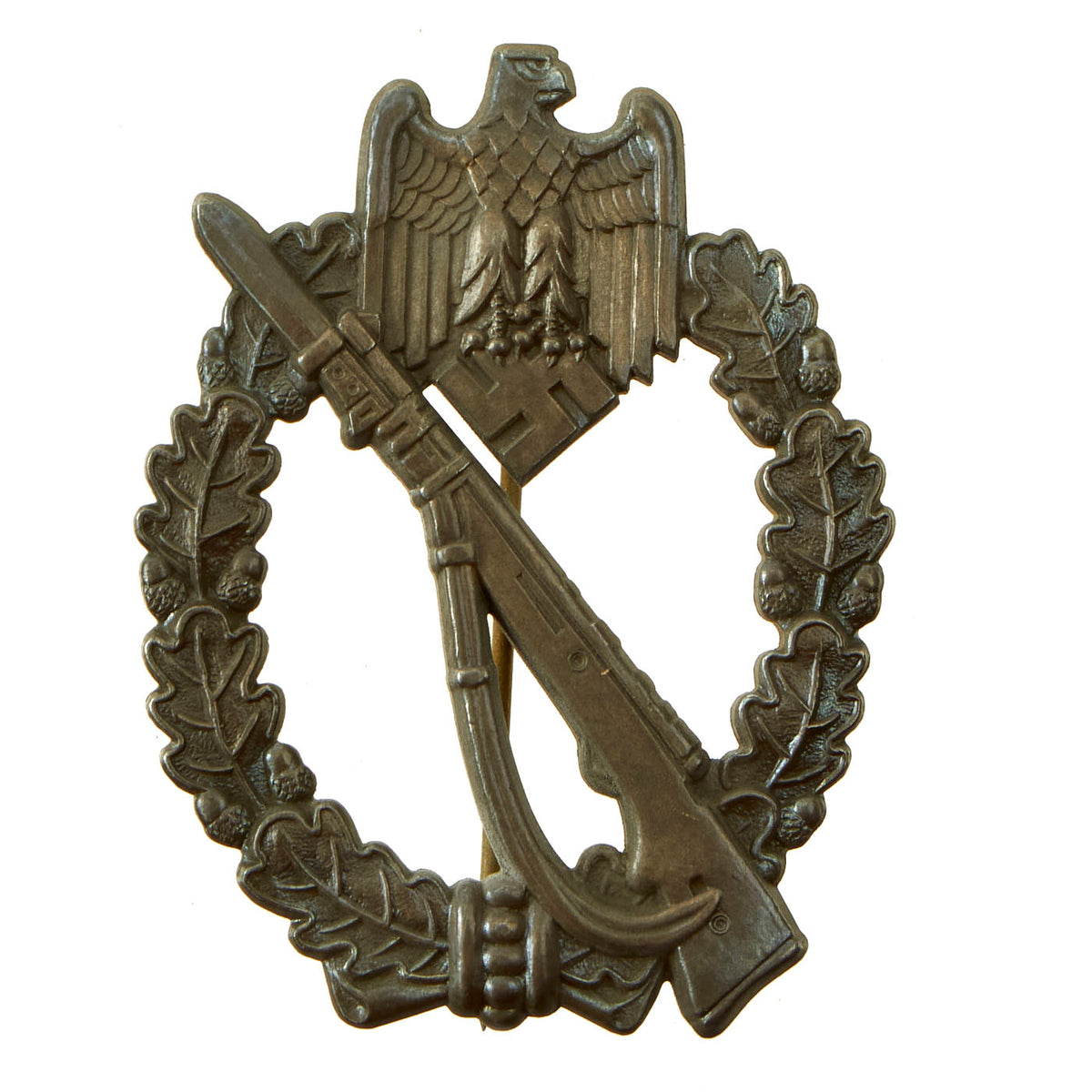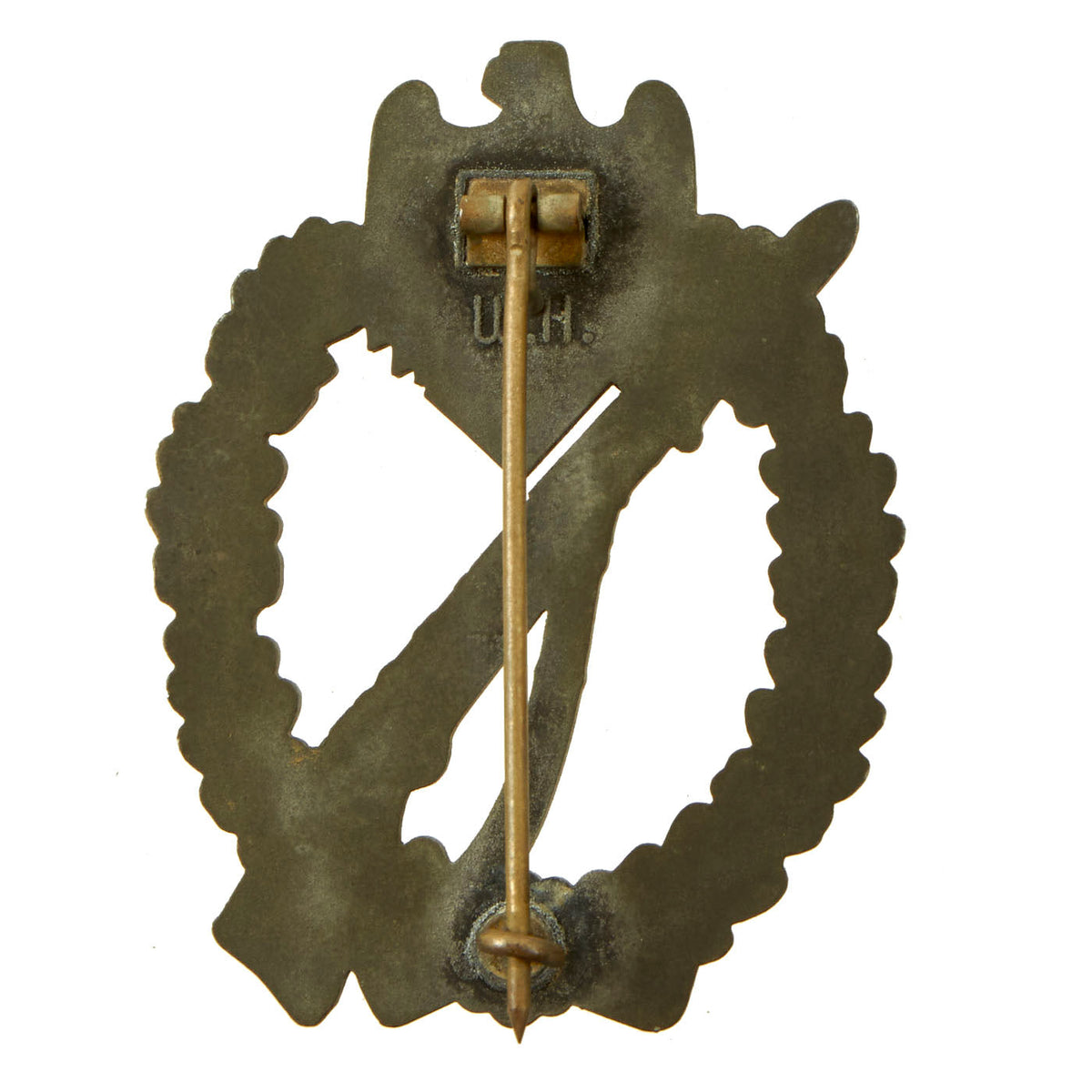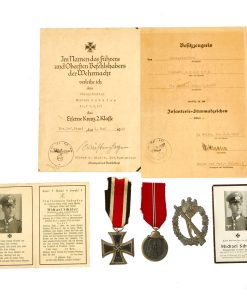Original German WWII Award & Document Grouping of Obergefreiter Michael Schäfer of I.R. 427 – KIA on Eastern Front 1942 Original Items
$ 695,00 $ 208,50
Original Items: One-of-a-kind grouping. This is a very interesting award and document grouping, named to Obergefreiter Michael Schäfer, who was Killed In Action on the Eastern Front on August 14th, 1942. It includes three original German WWII combat awards, two with their original BESITZZEUGNIS “possession/award” certificates, both named to Schäfer. It also includes the original mailed military correspondence regarding his death, as well as two different Sterbebild Death / Funeral Cards, which tell something of his life and service.
From the award documents, we can see that on 6. 4. 1942 Schäfer was awarded the Infantry Assault Badge when he held the rank of Obergefreiter, a senior enlisted rank equivalent to U.S. Army Corporal. Here he is listed as part of the 15. (Radf.) Komp. J.R. 427, which would be the 15th Radfahrkompanie (Bicycle Company) of Infantry Regiment 427. While not seen much in movies, bicycle troops were a sizable portion of infantry forces, and were very useful for scouting. They did no generate any motor noise, and required no fuel, making them very useful.
On 1. Mai 1942, Schäfer was awarded the Iron Cross 1939 2nd Class, and in this case the unit is just given as 15. / I.R. 427. There is no document for the Eastern Front Medal, which was almost certainly awarded posthumously.
The included letter looked to have been mailed to one Ludwig Schäfer, who we assume is Michael’s father. It is titled Betr. Privatsachen und Wertgegenstände des am 14.8.1942 in Russland gefallenen Michael Schäfer aus Ober-Erlenbach, Kreis Friedberg (Hessen)., which translates to “re Private belongings and valuables belonging to Michael Schäfer from Ober-Erlenbach, district of Friedberg (Hesse), who died in Russia on August 14, 1942.” The letter looks to be a follow up to the original death notice, regarding any personal effects that Schäfer had that were going to be returned, and also the manner of their return.
The two Death / Funeral Cards are mostly the same, with the smaller one giving only basic details about Schäfer. It also has an error, indicating that he had received the E. K. II u. Des Panzersturmabzeichen, which is incorrect, as he was in the infantry, and would have not received the panzer badge. Very rare to find a period typo like this! The larger card gives his awards correctly as E K 2, des Infanterie-Sturmabzeichens und der Ostmedaille. It also lists him as being part of a Grenadier-Regiment, as in 1942 Infantry Regiments were renamed as Grenadier Regiments by AH as a historical homage to Frederick the Great’s Army.
The three awards earned by Schäfer (in date order) are the Infanterie-Sturmabzeichen (Infantry Assault Badge), the Eisernes Kreuz II. Klasse 1939 (Iron Cross 2nd Class 1939 – EK II), and the Medaille Winterschlacht im Osten 1941/42 (Eastern Front Medal). All of the awards are in very good condition, and the medals both retain their original ribbons. The back of the Infantry Assault Badge is marked W.H. for maker Walter Henlein of Gablonz, part of the so-called “Sudetenland” during WWII.
The two included award documents measure approximately, 5.5″ x 8″, (14cm x 20cm), and are printed on mid-weight paper with black print and typed in particulars. Both are dated, with their correct stamps and signatures. There is no document for the Eastern Front Medal, which was almost certainly awarded posthumously. They are in good condition, with the expected wear and yellowing from age. They all show some folding and tearing, as expected of documents of this age. Please consult the pictures for condition specifics.
The death notice letter measures approximately 8 1/4″ x 11 1/2″, most likely equivalent to size “A4″, and is the usual lightweight paper used. The larger death / funeral card measures 5 3/4″ x 4 1/2″ unfolded, while the smaller measures 2 5/8″ x 4 1/8”. These all show folding and wear consistent with age and storage.
A very interesting award and document set from a German WWII soldier who was Killed in Action on the Eastern front of WWII. Definitely a fantastic translation project, with some great research potential as well. Ready to display!
There is no more iconic German military award than the Iron Cross. The long history of this order began during the Napoleonic Wars. King Friedrich Wilhelm III of Prussia instituted the “Eisernes Kreuz” (Iron Cross) in March of 1813. The award criteria changed somewhat with time, but generally speaking, Iron Crosses could be awarded for individual acts of bravery, or for leadership achievements on the battlefield. The design was created by a Karl Friedrich Schinkel, his choice of the black cross with silver outline was derived from the heraldic emblem of the Teutonic Knights.
The final reinstitution of the cross came in 1939. For this version, the front of the core for both grades bore a swas and the date 1939. The oak leaves, crown and royal initials were removed from the reverse, with only the date 1813 remaining as a reminder of the legacy of this award. In WWII, hundreds of thousands of Iron Cross First Class awards were bestowed, and four and a half million Iron Cross Second Class awards. Iron Crosses were made by a large number of authorized manufacturers. Some variants of these awards were mass produced in huge numbers. Others were made in very limited quantities.
The Eastern Front Medal (German: Medaille Winterschlacht im Osten 1941/42) was a World War II German military decoration awarded to both German and Axis personnel. It was awarded to those who served on the German Eastern Front during the winter campaign period of 15 November 1941 to 15 April 1942 It was instituted on 26 May 1942 and was commonly known as the Ostmedaille (East Medal) or Russian Front Medal.
The medal was wryly called the Frozen Meat Medal or the “Order of the Frozen Flesh” (German: Gefrierfleischorden) by Heer, Luftwaffe and Waffen-SS personnel to whom it was awarded.
Qualification
Armed service personnel qualified for the badge after a minimum of 14 days served in active combat; 30 combat sorties for Luftwaffe members; 60 days of continuous service in a combat zone; being wounded or suffering a “frozen limb”, severe enough to warrant the issue of a Wound Badge. The medal could be awarded posthumously.
The Infantry Assault Badge (German: Infanterie-Sturmabzeichen) was a German war badge awarded to Waffen-SS and Wehrmacht Heer soldiers during the Second World War. This decoration was instituted on 20 December 1939 by the Commander-in-Chief of the German Army, Generalfeldmarschall Walther von Brauchitsch. It could be awarded to members of non-motorized Infantry units and units of the Gebirgsjäger that had participated in infantry assaults, with light infantry weapons, on at least three separate days of battle in the front line on or after 1 January 1940. When a counter offensive led to fighting, it could also apply. Award of the Infantry Assault Badge was authorized at regimental command level.
Fast Shipping with Professional Packaging
Thanks to our longstanding association with UPS FedEx DHL, and other major international carriers, we are able to provide a range of shipping options. Our warehouse staff is expertly trained and will wrap your products according to our exact and precise specifications. Prior to shipping, your goods will be thoroughly examined and securely secured. We ship to thousands clients each day across multiple countries. This shows how we're dedicated to be the largest retailer on the internet. Warehouses and distribution centres can be located throughout Europe as well as the USA.
Note: Orders with more than one item will be assigned a processing date depending on the item.
Before shipping before shipping, we'll conduct a thorough inspection of the items you have ordered. Today, the majority of orders will be delivered within 48 hours. The delivery time will be between 3-7 days.
Returns
The stock is dynamic and we cannot completely manage it because multiple stakeholders are involved, including our factory and warehouse. So the actual stock may alter at any time. It's possible that you may not receive your order once the order has been made.
Our policy is valid for a period of 30 days. If you don't receive the product within 30 days, we are not able to issue a refund or an exchange.
You can only return an item if it is unused and in the same state as the day you received it. You must have the item in its original packaging.
Related products
Uncategorized
Armored Burgonet Helmet & Polearm from Scottish Castle Leith Hall Circa 1700 Original Items
Uncategorized
Uncategorized
Uncategorized
Uncategorized
Uncategorized
Uncategorized
Uncategorized
Uncategorized
Armoured Fighting Vehicles of the World: AFVs of World War One (Hardcover Book) New Made Items
Uncategorized
Uncategorized
Uncategorized
Uncategorized
Uncategorized
Uncategorized
Uncategorized
Uncategorized
Band of Brothers ORIGINAL GERMAN WWII Le. F.H. 18 10.5cm ARTILLERY PIECE Original Items
Uncategorized
Uncategorized
